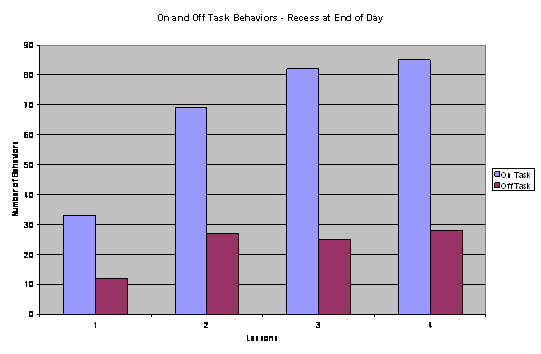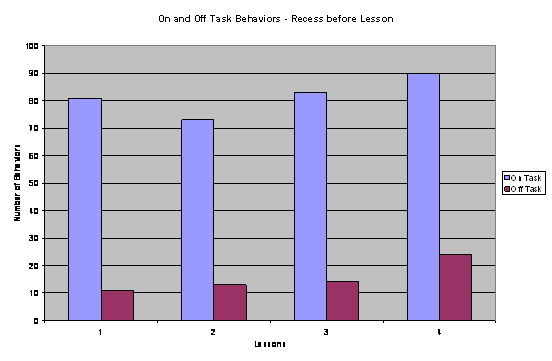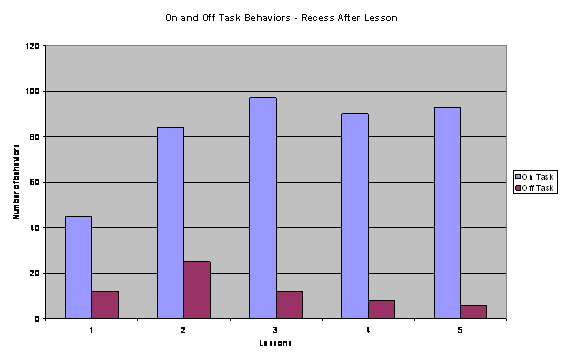

GIVE ME A BREAK! CAN STRATEGIC RECESS SCHEDULING INCREASE ON-TASK BEHAVIOUR FOR FIRST GRADERS?
Todd Fagerstrom & Kate Mahoney
Department of Language, Learning and Leadership, State University of New York, Fredonia
Abstract
The purpose of this study was to determine whether strategically scheduled recess breaks throughout the school day will increase student on-task behaviours during the time when they work independently. As an intervention for this action research study, recess breaks were given more often but for less time; recess breaks were scheduled before and after academic lessons throughout the whole day. Methodology included observations with checklist and field notes. Results of the study suggest that recess breaks scheduled directly before or after academic lessons positively affect student on-task behaviours.
Research Focus
As a first grade teacher in a rural western New York school, I usually schedule recess breaks after all academic material has been covered for the day. While there is no written rule governing recess in the school district, recess is traditionally offered once after all academic content is covered, and again at the end of the day. Some teachers even treat recess as optional and only give it as a reward if students have had good behaviour throughout the day. Because I also struggle with students' off-task behaviour, I was curious to see if they needed more recess breaks to help them focus during academic lessons. The action research study that emerged from this question partially fulfilled the requirements of my university to graduate with a Master's Degree, and will be summarized below.
Like many of my students, I believe recess is an important part of the day. Because our school has no written policy about recess, I informally observed some teachers granting recess as a reward for good behaviour, or simply offering recess as a random break scheduled during the course of the lessons. Yet, through informal conversations with other teachers at my school, it was clear that although recess was important, it was viewed as being completely detached from having any kind of academic benefits for students. From my observations as a student and teacher, the teaching of academic subjects followed a rigid schedule; moreover, it appeared that subjects were taught in order of importance; language arts in the morning, math in the early afternoon, and recess was usually at the end of the day and traditionally offered only once a day. The scheduling of recess was always delayed and somewhat uncertain; it seemed to occur after all of the important content had been covered for the day. Recess at the end of the day appeared to serve the purpose for students to socialize freely, and for teachers to grade papers, help a struggling student or just observe students.
Ultimately, I want to provide my students with the best education possible, and for me that means being a teacher informed of best practices. The purpose of this study, therefore, is to investigate how manipulating the recess schedule could benefit my students. In particular, will strategic recess scheduling increase on-task behaviour in my first grade classroom ? To assist in identification of an intervention to help answer my question, I looked to the literature on scheduling of recess. The following section integrates some of the important findings that helped in designing my study.
Literature Review
As defined by Pellegrini and Bjorklund (1997), recess usually serves a double purpose: students are allowed to take a break, either indoors or outdoors, from academic work, and is also allowed some freedom in choosing and engaging in an activity on their own terms. Like the current study, Pellegrini and Bjorklund experimented with the structure of recess and found that students learn better when they are given recess breaks during instruction. Similarly, Jarret, Maxwell, Dickerson, Hoge, Davies, and Yeteley (1998) found that fourth grade boys and girls were renewed by recess breaks as opposed to being disrupted by them. Students in this study demonstrated greater on-task behaviours on days when they had recess.
Other studies and reviews have shown that when recess breaks were delayed, students' off-task behaviours increased as time went on (Pellegrini & Davis, 1993; Pellegrini, Huberty, & Jones, 1995; Holmes, Pellegrini, & Schmidt, 2006; Waite-Stupiansky & Findlay, 2001). Pellegrini and Bohn (2005) discuss how the findings of studies such as the one conducted by Pellegrini and Smith (1993) found students to be more attentive after recess breaks than before them. The results of these studies also showed that students were more off-task when the period before recess was extended. This study is designed to test similar hypotheses as the above-mentioned authors.
Method
Participants
Participants in this study consisted of 16 first-grade students ranging in age from 6 to 7 years old. They were Caucasian students: 9 males and 7 females. Students were informed that as a part of his college class, Mr. Fagerstrom would be conducting a study that would help figure out what time of the day recess should be scheduled. The students were informed that there would be no repercussions if they chose not to participate in the research and that it was voluntary. Both parents and students received consent forms outlining the study being conducted, and explaining the purpose of the study. These were signed by all 16 students and a separate form was signed by their parents.
Intervention - Strategic Recess Scheduling
Historically, recess breaks are most often scheduled at the end of the day. In this first grade class, however, recess breaks were approximately 25 minutes and consisted of students either playing in the classroom or outside on the playground, depending on the weather. Students were free to choose what they did during these breaks.
The theory behind strategically scheduling recess is that if students are given recess earlier in the day and immediately before or after important academic lessons, they will behave more on-task during academic lessons. To experiment with having recess before and after an academic subject (mathematics was chosen for this study), recess was strategically placed either before or after the mathematics lesson, alternating every other day for two weeks (10 days). See Table 1 for a summary of the intervention schedule including the first week of traditional recess when baseline data was collected. Week one only included four days because of the Memorial Day Holiday.
Table 1. Summary of Intervention Schedule |
|
|
|||||||
|
|
|
|
|
|||||
Week One-Traditional Recess |
|||||||||
Day 1 |
Day 2 |
Day 3 |
Day 4 |
|
|||||
Math 11:35-12:10 |
Math 10:00-10:35 |
Math 11:35-12:10 |
Math 11:35-12:10 |
|
|||||
Recess 2:30-2:55 |
Recess 11:20-11:45 |
Recess 2:30-2:55 |
Recess 2:30-2:55 |
|
|||||
Week Two-Intervention
|
|||||||||
Day 5 |
Day 6 |
Day 7 |
Day 8 |
Day 9 |
|||||
Recess 1:45-2:10 |
Math 11:35-12:10 |
Recess 11:35-12:00 |
Math 11:35-12:10 |
Recess 11:35-12:00 |
|||||
Math 2:15-2:50 |
Recess 12:15-12:40 |
Math 12:05-12:40 |
Recess 12:15-12:40 |
Math 12:05-12:40 |
|||||
|
|
|
|
|
|||||
Week Three-Intervention
|
|||||||||
Day 10 |
Day 11 |
Day 12 |
Day 13 |
Day 14 |
|||||
Math 11:35-12:10 |
Recess 1:45-2:10 |
Math 11:35-12:10 |
Recess 11:35-12:00 |
Math 11:35-12:10 |
|||||
Recess 12:15-12:40 |
Math 2:15-2:50 |
Recess 12:15-12:40 |
Math 12:05-12:40 |
Recess 12:15-12:40 |
|||||
Data Collections Strategies
This action research study was designed as a quasi-experimental design with baseline data collected prior to the intervention, during and after. Primary data collection strategies were observations (with a checklist) and field notes taken by the teacher during the intervention. No changes were made to the curriculum, instruction, or the quality of recess; changes were only made to the scheduling of recess.
Using a checklist, students were observed for on and off-task behaviour during math lessons when completing independent practice activities. Independent practice sessions usually lasted 10-15 minutes which provided ample time to make many observations. While students were completing independent practice activities, observations were recorded every 5 seconds. When students needed assistance with their work, observations were momentarily stopped, while help was given. Students were observed for 5-second intervals, with the behaviour of the student during that time being recorded on the data sheet. Students were recorded as being on-task, off-task, or both. After the 5 seconds, the next student was observed, with the process being repeated throughout the duration of the independent practice time.
The checklist was designed by the first author to observe students behaviour and determine whether behaviours observed were on-task or off-task behaviour. The checklist was designed with a conceptual framework that considered the following behaviours on-task (completing problems, counting on hands, using number line, thinking about possible methods of completion) and off-task (playing inside desk, unnecessary drawing on practice sheet, and socializing with peers). On-task behaviours consisted of the students being actively engaged in their work. If students were not actively engaged in their work, for example playing inside their desk or talking to a classmate, they were considered off-task. Teacher field-notes were also examined to record any behaviours or comments made by students that were not recorded with the checklist.
Results
Results of field notes taken by the teacher/researcher yielded all positive comments from students about having more recess throughout the day, even if for less time per recess. Because many first graders are in the developmental process of conceptualizing time, more frequent recess to them meant more recess regardless of having similar amounts of time dedicated to recess. All student comments during intervention reflected they were ?happy? about having more frequent recess.
For each recess schedule, the observations of the on and off-task behaviours recorded were tallied and reported as bar charts. Recess before mathematics showed the most on-task behaviour and the least off-task behaviour. On-task behaviour occurred most during the intervention when recess was placed before mathematics (Figure 2) followed by recess after mathematics (Figure 3), then at the very end of the day (Figure 1). In addition, off-task behaviour occurred the least during the intervention when recess was placed before mathematics followed by recess-after-mathematics, then recess at the end of the day.

Figure 1

Figure 2

Figure 3
Discussion
The effect of recess scheduling on the students in my class were both interesting and obvious. More on-task behaviour was exhibited when recess was offered before mathematics, followed by recess-after-mathematics, and lastly the traditional recess scheduled at the end of the day. When students are more on-task, more learning takes place. With this in mind, the results of this study suggest that scheduling recess breaks directly before or after an academic lesson promotes greater on-task behaviours during independent practice sessions.
The results of this study are also consistent with Pellegrini and Bjorklund's (1997) research that suggests that distributed practice has a positive effect on student attention during school tasks. Jarrett and colleagues (1998) also suggested that instructional time without periodic breaks may be an inefficient use of precious instructional time. This creates a strong argument in favor of recess breaks scheduled strategically throughout the school day with the intent of promoting greater on-task behaviours and, in turn, greater retention of academic material.
Further studies that focus on strategic recess scheduling are needed to better understand the importance of recess in the elementary school curriculum as recess remains a tremendously understudied aspect of the school day. As a professional educator, I intend to implement these findings to inform my own classroom scheduling. While the purpose of this study was to first and foremost inform my own classroom practices, other teachers may also find this information useful.
References
Holmes, R.M., Pellegrini, A.D., & Schmidt (2006). The effects of different recess timing regimens on preschoolers' classroom attention. Early Child Development and Care , 7 , 735-743.
Jarrett, Maxwell, Dickerson, Hoge, Davies, and Yeteley, (1998). Impact of recess on classroom behavior: Group effects and individual differences. The Journal of Educational Research, 92, 121-126.
Pellegrini, A. D. & Bjorklund, D. F. (1997). The role of recess in children's cognitive performance. Educational Psychologist, 32 , 35-40.
Pellegrini, A. D. & Bohn, C. M. (2005). The role of recess in children's cognitive performance and school adjustment. Educational Researcher, 34, 13-19.
Pellegrini, A.D. & Davis, P. (1993). Confinement effects on playground and classroom behavior. British Journal of Educational Psychology , 63 , 88-95.
Pellegrini, A.D., Huberty, P.D., & Jones, I. (1995). The effects of play deprivation on children's recess and classroom behaviors. American Educational Research Journal , 32 , 845-864.
Pellegrini, A. D. & Smith, P. K. (1993). School recess: Implications for education and development. Review of Educational Research, 63, 51-67.
Waite-Stupiansky, S. & Findlay, M. (2001). The fourth r: Recess and its link to learning. The Educational Forum, 66, 16-25.
Biographical Note:
Todd Fagerstrom is a first grade teacher at Southwestern Central School District in southern New York who recently graduated from State University of New York (SUNY) Fredonia with a Master's degree in Curriculum and Instruction. His research interests include using action research to improve his career as a first grade teacher.
Dr. Kate Mahoney is an assistant professor in the Department of Language, Learning, and Leadership at SUNY Fredonia. She teaches research courses and serves as thesis director for students conducting their Master's Thesis in Curriculum and Instruction (C&I) and Teaching English as a Second language (TESOL) graduate programs. Her current research addresses the validity of using achievement and language proficiency test scores for English Language Learners (ELLs), meta-analysis, and action research. She can be reached at SUNY Fredonia Department of Language, Learning, and Leadership, College of Education , E254 Thompson Hall, Fredonia, NY 14063, kate.mahoney@fredonia.edu
